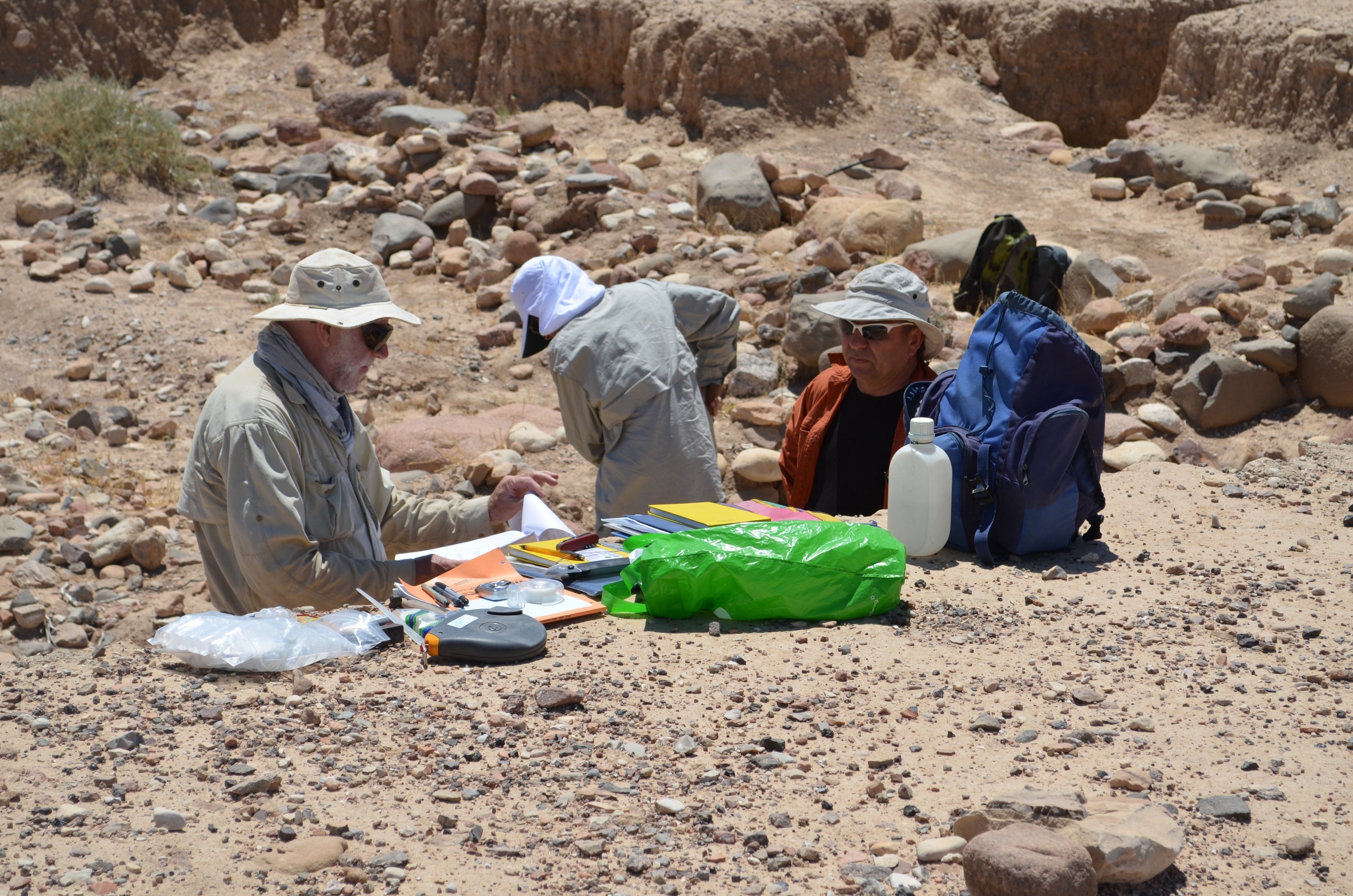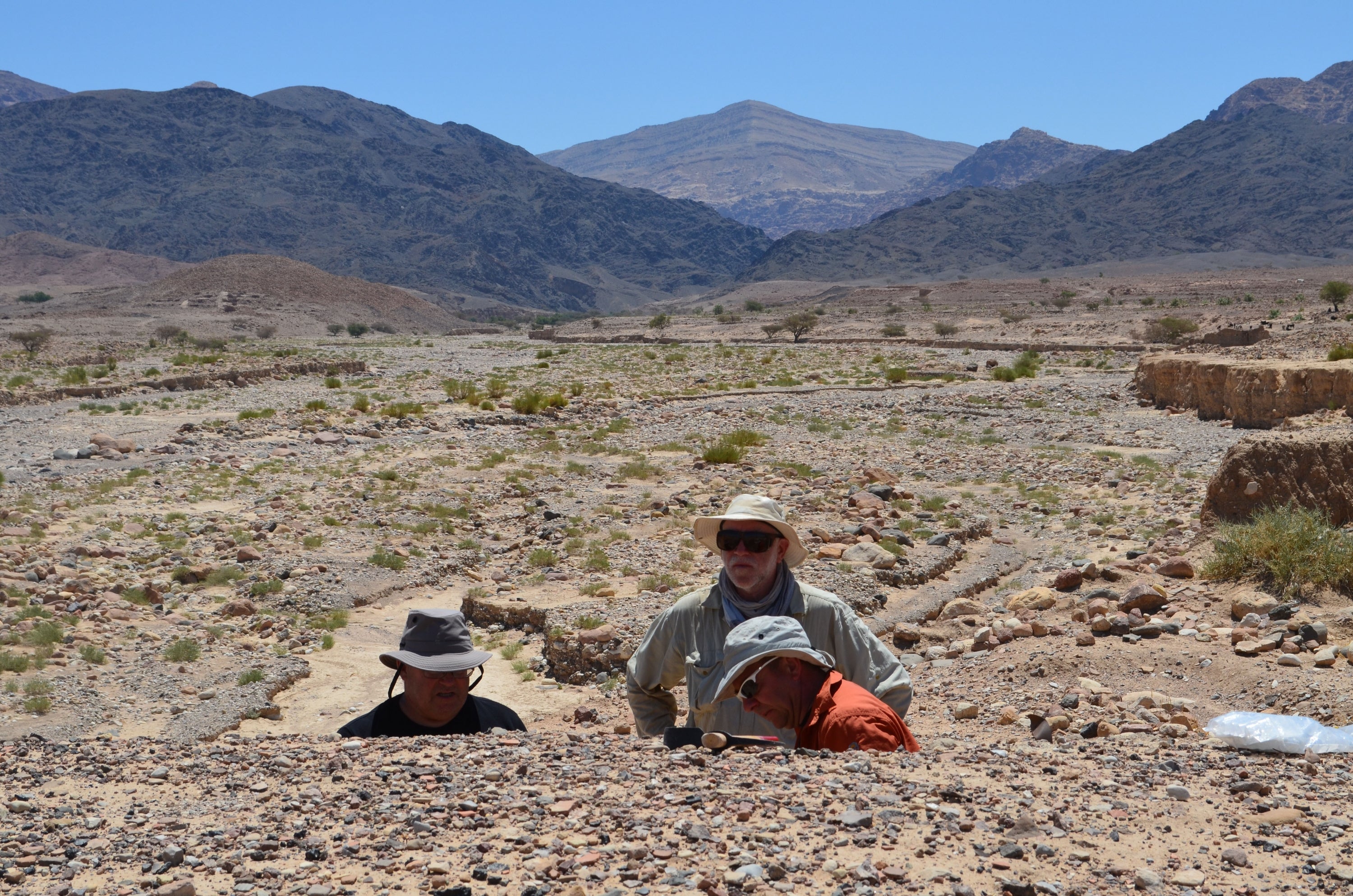Industrial pollution may seem like a modern phenomenon. In fact, University of Waterloo anthropology Professor Russell Adams and his colleagues may have discovered what could be the first polluted river, contaminated approximately 7,000 years ago.

Professor David Gilbertson, UWaterloo student Manual Arab and Dr. Keith Haylock examine upper sections at Tell Wadi Faynan. Photography by Sue Haylock and courtesy of the Barqa Landscape Project.
In this now-dry river, in the Wadi Faynan region of southern Jordan, the researchers found evidence of early pollution caused by the combustion of copper. Late Neolithic humans, researchers know, had control of fire, were building pottery and even creating jewelry out of the blue-green copper ores found in abundance in this area; they had access to all the elements needed to create copper. So, while researchers didn’t find pottery vessels for smelting metal or copper tools dating back this far, evidence of intense copper pollution and fires in this area suggest humans may have been in the early stages of developing metallurgy.
“These populations were experimenting with fire, experimenting with pottery and experimenting with copper ores, and all three of these components are part of the early production of copper metals from ores,” says Adams.
The research findings, recently published in Science of the Total Environment, shed light on a turning point in history, when humans began moving from making tools out of stones to making tools out of metal. This period, known as the Chalcolithic or Copper Age, is a transitional period between the late Neolithic, or Stone Age, and the beginning of the Bronze Age.
Copper was created at this time by combining charcoal and ore in pottery crucibles, or vessels, and heating it over a fire. Making copper “would have been the ultimate light show,” says Adams, “because when you heat these ores, you get these really incredible vapours of orange and blue and green.”

Dr. Russell Adams, Professor David Gilbertson and Dr. Keith Haylock examine upper sections at Tell Wadi Faynan. Photography by Sue Haylock and courtesy of the Barqa Landscape Project.
Though the process was beautiful, it was time- and labour-intensive. For this reason, it took thousands of years before copper became a central part of human societies. In the earliest phase of copper production, many objects created were primarily symbolic and fulfilled a social function within society. “This was how individuals attained prestige within their societies, by attaining rare and exotic things,” he says.
The metallurgists, too, would have had high social status. “What they were able to do must have seemed magical since they took rock and turned it into a really highly prized, beautiful, shiny piece of metal.”
As time passed, communities in the region grew larger and copper production expanded. Mines were built, then large smelting furnaces and, finally, by about 2,600 BC, factories. “This region is home to the world’s first industrial revolution,” says Adams. “This was the Silicon Valley of the age. It really was the centre of innovative technology.”
But people paid a heavy price for the increased metal production. Slag, the waste product of smelting, would be left behind. It contained metals such as copper, lead, zinc, cadmium – and even arsenic, mercury and thallium. These metals were absorbed into plants, which were then eaten by people and animals such as goats and sheep, and would bioaccumulate in the environment.
The pollution from thousands of years of copper mining and production must have led to widespread health problems in ancient populations, says Adams. Infertility, malformations and premature death would have been some of the effects. To date, high levels of copper and lead have been found in human bones dating back to the Roman period.
Adams and his international team of researchers are now trying to expand the analysis of the effects of this pollution to the Bronze Age. The Faynan region has a long history of human occupation, and the team is examining the extent and spread of this pollution at the time when metals and their industrial scale production became central to human societies.
“The technological innovation and the spread of the adoption and use of metals in society mark the beginning of the modern world,” says Adams.
Please visit the Department of Anthropology’s display case for artifacts from this area.

Wadi Faynan and the upper sections of Tell Wadi Faynan (lower right). Photography by Sue Haylock, courtesy of the Barqa Landscape Project.